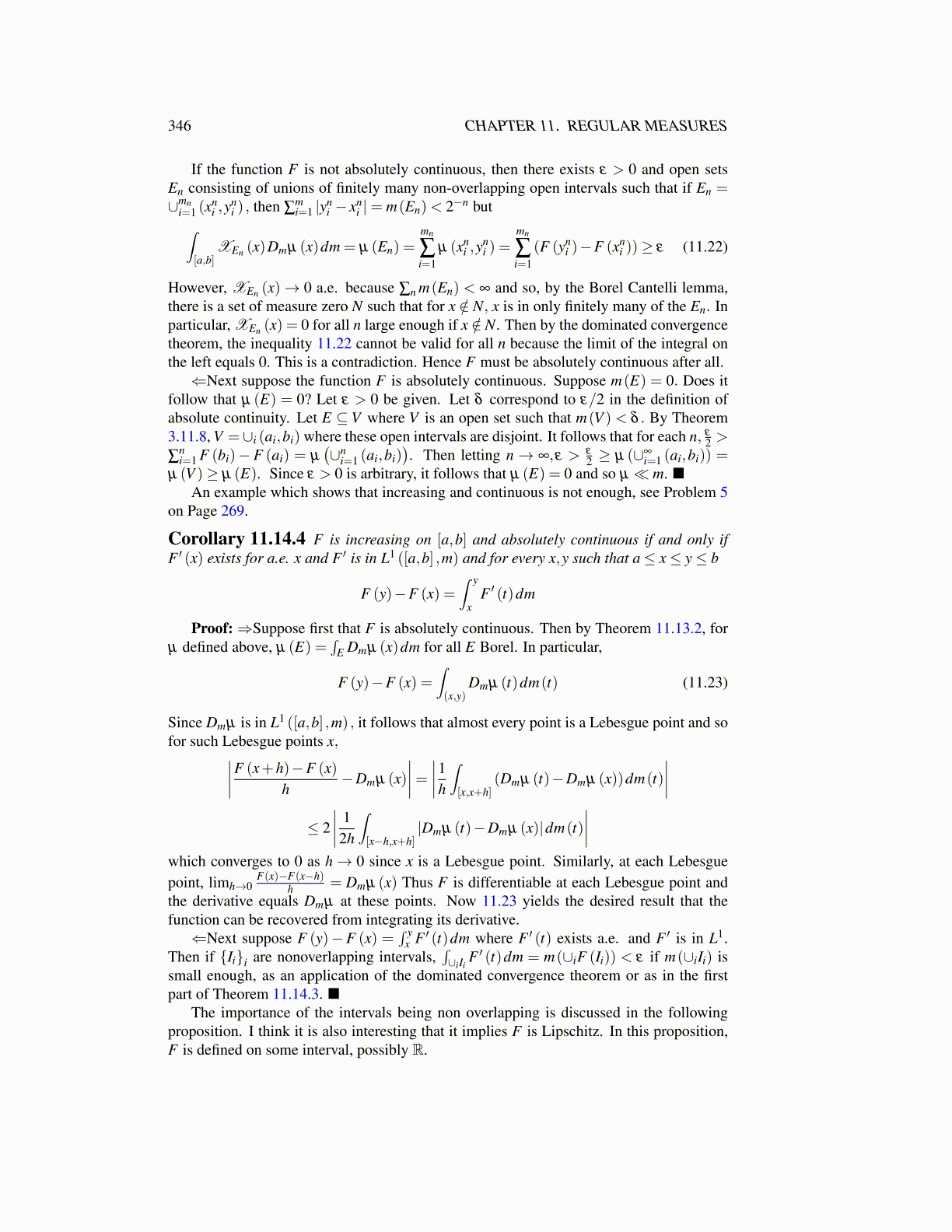
346 CHAPTER 11. REGULAR MEASURES
If the function F is not absolutely continuous, then there exists ε > 0 and open setsEn consisting of unions of finitely many non-overlapping open intervals such that if En =∪mn
i=1 (xni ,y
ni ) , then ∑
mi=1 |yn
i − xni |= m(En)< 2−n but∫
[a,b]XEn (x)Dmµ (x)dm = µ (En) =
mn
∑i=1
µ (xni ,y
ni ) =
mn
∑i=1
(F (yni )−F (xn
i ))≥ ε (11.22)
However, XEn (x)→ 0 a.e. because ∑n m(En) < ∞ and so, by the Borel Cantelli lemma,there is a set of measure zero N such that for x /∈ N, x is in only finitely many of the En. Inparticular, XEn (x) = 0 for all n large enough if x /∈ N. Then by the dominated convergencetheorem, the inequality 11.22 cannot be valid for all n because the limit of the integral onthe left equals 0. This is a contradiction. Hence F must be absolutely continuous after all.⇐Next suppose the function F is absolutely continuous. Suppose m(E) = 0. Does it
follow that µ (E) = 0? Let ε > 0 be given. Let δ correspond to ε/2 in the definition ofabsolute continuity. Let E ⊆ V where V is an open set such that m(V ) < δ . By Theorem3.11.8, V =∪i (ai,bi) where these open intervals are disjoint. It follows that for each n, ε
2 >
∑ni=1 F (bi)−F (ai) = µ
(∪n
i=1 (ai,bi)). Then letting n→ ∞,ε > ε
2 ≥ µ (∪∞i=1 (ai,bi)) =
µ (V )≥ µ (E). Since ε > 0 is arbitrary, it follows that µ (E) = 0 and so µ ≪ m. ■An example which shows that increasing and continuous is not enough, see Problem 5
on Page 269.
Corollary 11.14.4 F is increasing on [a,b] and absolutely continuous if and only ifF ′ (x) exists for a.e. x and F ′ is in L1 ([a,b] ,m) and for every x,y such that a≤ x≤ y≤ b
F (y)−F (x) =∫ y
xF ′ (t)dm
Proof:⇒Suppose first that F is absolutely continuous. Then by Theorem 11.13.2, forµ defined above, µ (E) =
∫E Dmµ (x)dm for all E Borel. In particular,
F (y)−F (x) =∫(x,y)
Dmµ (t)dm(t) (11.23)
Since Dmµ is in L1 ([a,b] ,m) , it follows that almost every point is a Lebesgue point and sofor such Lebesgue points x,∣∣∣∣F (x+h)−F (x)
h−Dmµ (x)
∣∣∣∣= ∣∣∣∣1h∫[x,x+h]
(Dmµ (t)−Dmµ (x))dm(t)∣∣∣∣
≤ 2∣∣∣∣ 12h
∫[x−h,x+h]
|Dmµ (t)−Dmµ (x)|dm(t)∣∣∣∣
which converges to 0 as h→ 0 since x is a Lebesgue point. Similarly, at each Lebesguepoint, limh→0
F(x)−F(x−h)h = Dmµ (x) Thus F is differentiable at each Lebesgue point and
the derivative equals Dmµ at these points. Now 11.23 yields the desired result that thefunction can be recovered from integrating its derivative.⇐Next suppose F (y)−F (x) =
∫ yx F ′ (t)dm where F ′ (t) exists a.e. and F ′ is in L1.
Then if {Ii}i are nonoverlapping intervals,∫∪iIi F ′ (t)dm = m(∪iF (Ii)) < ε if m(∪iIi) is
small enough, as an application of the dominated convergence theorem or as in the firstpart of Theorem 11.14.3. ■
The importance of the intervals being non overlapping is discussed in the followingproposition. I think it is also interesting that it implies F is Lipschitz. In this proposition,F is defined on some interval, possibly R.